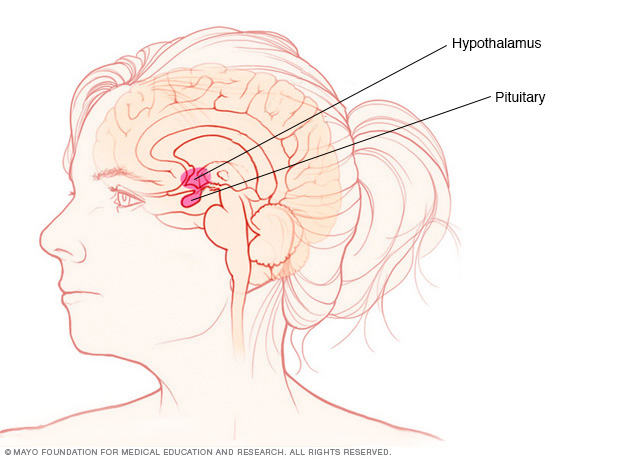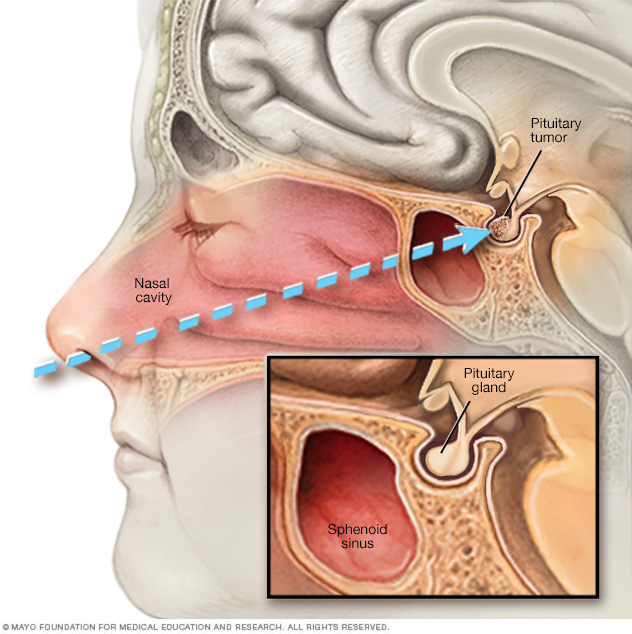Acromegaly
Overview
Acromegaly is a hormonal disorder that develops when your pituitary gland produces too much growth hormone during adulthood.
When you have too much growth hormone, your bones increase in size. In childhood, this leads to increased height and is called gigantism. But in adulthood, a change in height doesn't occur. Instead, the increase in bone size is limited to the bones of your hands, feet and face, and is called acromegaly.
Because acromegaly is uncommon and the physical changes occur slowly over many years, the condition sometimes takes a long time to recognize. Untreated, high levels of growth hormone can affect other parts of the body, in addition to your bones. This can lead to serious — sometimes even life-threatening — health problems. But treatment can reduce your risk of complications and significantly improve your symptoms, including the enlargement of your features.

Symptoms of acromegaly include an enlarged face and hands. Changes to the face may cause the brow bone and lower jawbone to protrude, and the nose and lips to get larger.
Symptoms
A common sign of acromegaly is enlarged hands and feet. For example, you may notice that you aren't able to put on rings that used to fit, and that your shoe size has progressively increased.
Acromegaly may also cause gradual changes in your face's shape, such as a protruding lower jaw and brow bone, an enlarged nose, thickened lips, and wider spacing between your teeth.
Because acromegaly tends to progress slowly, early signs may not be obvious for years. Sometimes, people notice the physical changes only by comparing old photos with newer ones.
Overall, acromegaly signs and symptoms tend to vary from one person to another, and may include any of the following:
- Enlarged hands and feet.
- Enlarged facial features, including the facial bones, lips, nose and tongue.
- Coarse, oily, thickened skin.
- Excessive sweating and body odor.
- Small outgrowths of skin tissue (skin tags).
- Fatigue and joint or muscle weakness.
- Pain and limited joint mobility.
- A deepened, husky voice due to enlarged vocal cords and sinuses.
- Severe snoring due to obstruction of the upper airway.
- Vision problems.
- Headaches, which may be persistent or severe.
- Menstrual cycle irregularities in women.
- Erectile dysfunction in men.
- Loss of interest in sex.
When to see a doctor
If you have signs and symptoms associated with acromegaly, contact your doctor for an exam.
Acromegaly usually develops slowly. Even your family members may not notice the gradual physical changes that occur with this disorder at first. But early diagnosis is important so that you can start getting proper care. Acromegaly can lead to serious health problems if it's not treated.
Causes
Acromegaly occurs when the pituitary gland produces too much growth hormone (GH) over a long period of time.
The pituitary gland is a small gland at the base of your brain, behind the bridge of your nose. It produces GH and a number of other hormones. GH plays an important role in managing your physical growth.
When the pituitary gland releases GH into your bloodstream, it triggers your liver to produce a hormone called insulin-like growth factor-1 (IGF-1) — sometimes also called insulin-like growth factor-I, or IGF-I. IGF-1 is what causes your bones and other tissues to grow. Too much GH leads to too much IGF-1, which can cause acromegaly signs, symptoms and complications.
In adults, a tumor is the most common cause of too much GH production:
- Pituitary tumors. Most acromegaly cases are caused by a noncancerous (benign) tumor (adenoma) of the pituitary gland. The tumor produces excessive amounts of growth hormone, causing many of the signs and symptoms of acromegaly. Some of the symptoms of acromegaly, such as headaches and impaired vision, are due to the tumor pressing on nearby brain tissues.
- Nonpituitary tumors. In a few people with acromegaly, tumors in other parts of the body, such as the lungs or pancreas, cause the disorder. Sometimes, these tumors secrete GH. In other cases, the tumors produce a hormone called growth hormone-releasing hormone (GH-RH), which signals the pituitary gland to make more GH.

The pituitary gland and the hypothalamus are in the brain. They control hormone production.
Risk factors
People who have a rare genetic condition called multiple endocrine neoplasia, type 1 (MEN 1), have a higher risk of developing acromegaly. In MEN 1, the endocrine glands — usually the parathyroid glands, pancreas and pituitary gland — grow tumors and release extra hormones. Those hormones may trigger acromegaly.
Complications
If left untreated, acromegaly can lead to major health problems. Complications may include:
- High blood pressure (hypertension).
- High cholesterol.
- Heart problems, particularly enlargement of the heart (cardiomyopathy).
- Osteoarthritis.
- Type 2 diabetes.
- Enlargement of the thyroid gland (goiter).
- Precancerous growths (polyps) on the lining of your colon.
- Sleep apnea, a condition in which breathing repeatedly stops and starts during sleep.
- Carpal tunnel syndrome.
- Increased risk of cancerous tumors.
- Spinal cord compression or fractures.
- Vision changes or vision loss.
Early treatment of acromegaly can prevent these complications from developing or becoming worse. Untreated, acromegaly and its complications can lead to premature death.
Diagnosis
Your doctor will ask about your medical history and conduct a physical exam. Then he or she may recommend the following steps:
- IGF-1 measurement. After you've fasted overnight, your doctor will take a blood sample to measure the IGF-1 level in your blood. An elevated IGF-1 level suggests acromegaly.
- Growth hormone suppression test. This is the best method for confirming an acromegaly diagnosis. During this test, your GH blood level is measured both before and after you drink a preparation of sugar (glucose). In people who don't have acromegaly, the glucose drink typically causes the GH level to fall. But if you have acromegaly, your GH level will tend to stay high.
- Imaging. Your doctor may recommend an imaging test, such as magnetic resonance imaging (MRI), to help pinpoint the location and size of a tumor on your pituitary gland. If no pituitary tumors are seen, your doctor may order other imaging tests to look for nonpituitary tumors.
Treatment
Acromegaly treatment varies by person. Your treatment plan will likely depend on the location and size of your tumor, the severity of your symptoms, and your age and overall health.
To help lower your GH and IGF-1 levels, treatment options typically include surgery or radiation to remove or reduce the size of the tumor that is causing your symptoms, and medication to help normalize your hormone levels.
If you're experiencing health problems as a result of acromegaly, your doctor may recommend additional treatments to help manage your complications.
Surgery
Doctors can remove most pituitary tumors using a method called transsphenoidal surgery. During this procedure, your surgeon works through your nose to remove the tumor from your pituitary gland. If the tumor causing your symptoms isn't located on your pituitary gland, your doctor will recommend another type of surgery to remove the tumor.
In many cases — especially if your tumor is small — removal of the tumor returns your GH levels to normal. If the tumor was putting pressure on the tissues around your pituitary gland, removing the tumor also helps relieve headaches and vision changes.
In some cases, your surgeon may not be able to remove the entire tumor. If this is the case, you may still have elevated GH levels after surgery. Your doctor may recommend another surgery, medications or radiation treatments.
Medications
Your doctor may recommend one of the following medications — or a combination of medications — to help your hormone levels return to normal:
- Drugs that reduce growth hormone production (somatostatin analogues). In the body, a brain hormone called somatostatin works against (inhibits) GH production. The drugs octreotide (Sandostatin) and lanreotide (Somatuline Depot) are man-made (synthetic) versions of somatostatin. Taking one of these drugs signals the pituitary gland to produce less GH, and may even reduce the size of a pituitary tumor. Typically, these drugs are injected into the muscles of your buttocks (gluteal muscles) once a month by a health care professional.
- Drugs to lower hormone levels (dopamine agonists). The oral medications cabergoline and bromocriptine (Parlodel) may help lower levels of GH and IGF-1 in some people. These drugs may also help decrease tumor size. To treat acromegaly, these medications usually need to be taken at high doses, which can increase the risk of side effects. Common side effects of these drugs include nausea, vomiting, stuffy nose, tiredness, dizziness, sleep problems and mood changes.
- Drug to block the action of GH (growth hormone antagonist). The medication pegvisomant (Somavert) blocks the effect of GH on the body's tissues. Pegvisomant may be particularly helpful for people who haven't had good success with other treatments. Given as a daily injection, this medication can help lower IGF-1 levels and relieve symptoms, but it doesn't lower GH levels or reduce tumor size.
Radiation
If your surgeon wasn't able to remove the whole tumor during surgery, your doctor may recommend radiation treatment. Radiation therapy destroys any lingering tumor cells and slowly reduces GH levels. It may take years for this treatment to noticeably improve acromegaly symptoms.
Radiation treatment often lowers levels of other pituitary hormones, too — not just GH. If you receive radiation treatment, you'll likely need regular follow-up visits with your doctor to make sure that your pituitary gland is working properly, and to check your hormone levels. This follow-up care may last for the rest of your life.
Types of radiation therapy include:
- Conventional radiation therapy. This type of radiation therapy is usually given every weekday over a period of four to six weeks. You may not see the full effect of conventional radiation therapy for 10 or more years after treatment.
- Stereotactic radiosurgery. Stereotactic radiosurgery uses 3D imaging to deliver a high dose of radiation to the tumor cells, while limiting the amount of radiation to normal surrounding tissues. It can usually be delivered in a single dose. This type of radiation may bring GH levels back to normal within five to 10 years.

In transnasal transsphenoidal endoscopic surgery, a surgical instrument is placed through the nostril and alongside the nasal septum to access a pituitary tumor.
Preparing for an appointment
You'll probably first see your family doctor or a general doctor. However, in some cases, you may be referred immediately to a doctor who specializes in hormonal disorders (endocrinologist).
It's good to prepare for your appointment. Here's some information to help you get ready for your appointment and to know what to expect from your doctor.
What you can do
- Be aware of any pre-appointment restrictions. When you make the appointment, ask if there's anything you need to do to prepare for diagnostic tests.
- Write down the symptoms you're experiencing. Keep track of anything causing you discomfort or concern, such as headaches, vision changes or discomfort in your hands, even if those things seem unrelated to the reason for which you scheduled the appointment.
- Write down key personal information, including any changes in your sex life or, for women, in your menstrual cycle.
- Make a list of all medications, vitamins and supplements you're taking.
- Take along old photographs that your doctor can use to compare against your appearance today. Your doctor will likely be interested in photos from 10 years ago through the present.
- Take along a family member or friend, if possible. The person who accompanies you may remember something that you miss or forget.
- Write down questions to ask your doctor.
Preparing a list of questions will help you make the most of your time with your doctor. For acromegaly, some basic questions to ask your doctor include:
- What's the most likely cause of my symptoms?
- Other than the most likely cause, what are possible causes for my symptoms or condition?
- What tests do I need?
- What treatments are available for this condition? Which approach do you recommend?
- How long will I need treatment before my symptoms improve?
- With treatment, will I go back to looking and feeling as I did before I developed symptoms of acromegaly?
- Will I have long-term complications from this condition?
- I have other health conditions. How can I best manage the conditions together?
- Should I see a specialist?
- Is there a generic alternative to the medicine you're prescribing?
- Are there brochures or other printed material I can take with me? What websites do you recommend?
Don't hesitate to ask any other questions you have.
What to expect from your doctor
Your doctor is likely to ask you a number of questions, including:
- What symptoms are you experiencing, and when did they appear?
- Have you noticed any changes in how you feel or how you look? Has your sex life changed? How are you sleeping? Do you have headaches or joint pain, or has your vision changed? Have you noticed excessive sweating?
- Does anything seem to improve or worsen your symptoms?
- How much would you say your features have changed over time? Do you have old pictures I can use for comparison?
- Do your old shoes and rings still fit? If not, how much has their fit changed over time?
- Have you had colon cancer screening?
Last Updated Feb 6, 2024
© 2024 Mayo Foundation for Medical Education and Research (MFMER). All rights reserved. Terms of Use



